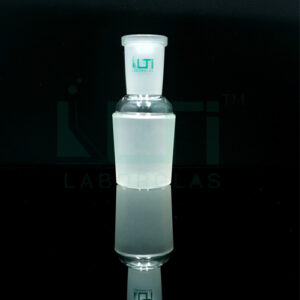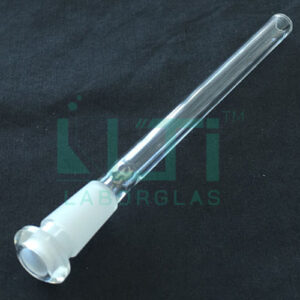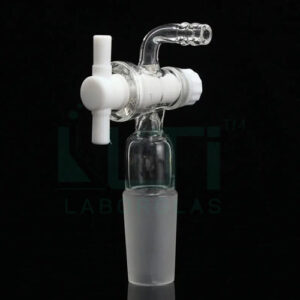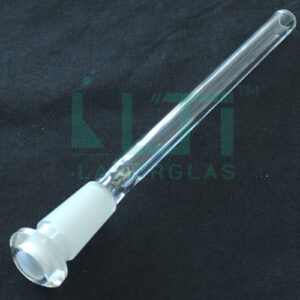Conformity to ISO 383/DIN 12249 Standards.
| Part No. | CONE Size | Approx. O.D. Of Tube | Total length (mm) | Pack (qty.) |
| 1240-10C | 10/19 | 8 | 90±5 | 12 |
| 1240-14C | 14/23 | 13 | 90±5 | 12 |
| 1240-19C | 19/26 | 16 | 90±5 | 12 |
| 1240-24C | 24/29 | 22 | 110±10 | 12 |
| 1240-29C | 29/32 | 26 | 110±10 | 12 |
| 1240-34C | 34/35 | 30 | 120±10 | 12 |
Here are some potential uses for a cone with drip tip double joint in a laboratory setting:
- Fractionation Columns: These joints can be used in the assembly of fractionation columns where precise control of liquid flow is crucial. The drip tip allows for controlled collection of fractions during distillation or fractionation processes.
- Distillation Setups: The drip tip feature is beneficial in distillation setups where it aids in the controlled collection of distillate. This is particularly useful in fractional distillation, where the separation of components is based on boiling point differences.
- Liquid Collection Systems: The drip tip double joint can be incorporated into systems designed for collecting liquids in a controlled manner. This is applicable in experiments where accurate measurement or separation of liquids is essential.
- Reaction Vessel Assembly: In chemical synthesis or reaction setups, these joints can be used to connect reaction vessels, condensers, or other glassware components. The drip tip can be useful for collecting reaction products in a controlled manner.
- Analytical Chemistry Applications: In analytical techniques where precise liquid handling is required, such as liquid chromatography, the cone with drip tip double joint can be part of the system for controlled sample collection or injection.
- Fluid Transfer Setups: These joints are suitable for fluid transfer setups, where controlled dispensing or collection of liquids is needed. The drip tip ensures that the liquid is directed with precision.
- Vacuum Applications: In vacuum systems, the cone with drip tip double joint may be used to assemble setups where a controlled liquid flow is required under vacuum conditions.
- Custom Glassware Configurations: Researchers may use these joints in the assembly of custom glassware configurations for specific experimental needs. The versatility of these joints allows for adaptability in designing experimental apparatus.
- Educational Demonstrations: In educational laboratories, cone with drip tip double joints can be used for teaching purposes. They allow students to assemble and disassemble glassware setups for experiments involving controlled liquid handling.
- Research and Development: Laboratories involved in research and development activities may use cone with drip tip double joints for designing and testing new equipment or setups that involve precise liquid handling.





